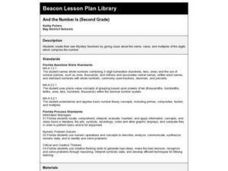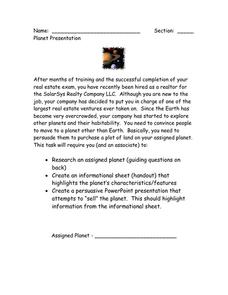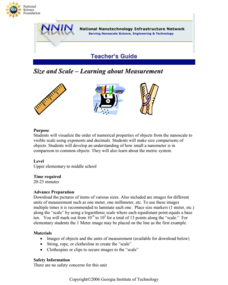Curated OER
School Bill of Rights
Students study the Bill of Rights. As a class, they create a "School Bill of Rights," with amendments. Students discuss the difference between rights and responsibilities and examine Supreme Court decisions dealing with the first ten...
Curated OER
Ordering Rational Numbers and Finding Their Approximate
Middle schoolers explore the concept of ordering rational numbers on a number line. They represent rational numbers as decimals and percents. Pupils create a foldable about converting fractions to decimals to percents, and use a...
Curated OER
101 Equals Five
Eighth graders engage in a game which focuses on the binary number system. Have one student leave the classroom. They remain in the class and decide on a number between 0 and 32. They come back inside and tries to figure out the number.
Curated OER
Food Forensics: A Case of Mistaken Identity
Learners develop an experiment to test a hypothesis. They use their knowledge of antigen-antibody specificity to develop a hypothesis. Students articulate that the antibody-antigen specificity is one part of the immune system. They...
Curated OER
And the Number Is (Second Grade)
Second graders create Mystery Numbers. They give the class clues about the name, value, and multiples of the digits which make up the number.
Curated OER
Converting Measurement Pretest
In this measure conversion learning exercise, 3rd graders answer ten multiple choice questions based on converting measurements.
Curated OER
Practice Exam III
In this chemistry practice exam worksheet, students solve ten multiple choice questions about equilibrium, acids, bases and reactions. Students then solve four problems about equilibrium and chemical reactions of acids and bases.
Curated OER
Zip Codes
Students discover how a zip code is used. In this zip code lesson, students use the parts of a zip code to find where a letter is going, then find the first number of zip codes based on geographic regions.
Curated OER
Now You Have It, Now You Don't
Students compare shipping peanuts made from corn and made from Styrofoam. In this corn based peanuts lesson, students understand why to use eco-friendly materials for packing. Students participate in an experiment to compare the...
Alabama Learning Exchange
Weather Word Search
Third graders search the Internet for ten weather words which they define. They use the words to design an original weather word search using a web based resource.
Mr. Jones's Science Class
Planet Presentation
Upper-elementary astronomers take on the role of interplanetary real estate salesmen. They research an assigned planet and create a PowerPoint to persuade the rest of the class to purchase property and move there. This fun project would...
Curated OER
Toilet Paper Solar System
Students create a model of the distances of the planets in the solar system using sheets of toilet paper and markers. Generally accepted orbital parameters are applied.
Curated OER
Five Senses: Brave Little Monster
Students identify which of the five senses is being used at a given time. They read "Brave Little Monster" by Ken Baker and then read the story again as they match student-made cards depicting the five senses to moments in the story.
EngageNY
Polynomial, Rational, and Radical Relationships
This assessment pair goes way beyond simple graphing, factoring and solving polynomial equations, really forcing learners to investigate the math ideas behind the calculations. Short and to-the-point questions build on one another,...
K12 Reader
Exponential Notation
Standard notation, exponential notation, base numbers and exponents are featured in an article designed to be used as a reading comprehension exercise. Kids read the passage and then respond to the comprehension questions attached to the...
Southern Nevada Regional Professional Development Program
“Just a Minute” Focus: Adapting Speech
A little bit complicated, but a whole lot of fun. Show your class an episode of the British television game show Just a Minute. After an explanation of the rules (no repetition, hesitation, or deviation) groups develop topics, based on...
National Nanotechnology Infrastructure Network
Size and Scale – Learning about Measurement
Can you visualize one billionth of a meter? It's not easy to understand the scale of a nanometer. Learners use a hands-on lesson to develop an understanding of the size of a nanometer in comparison to common objects. They walk away with...
Curated OER
And Justice For All
Students compare three justice systems currently in place in the United States: the civilian criminal justice system, the military criminal justice system (courts-martial) and the secret wartime tribunals that President Bush has proposed...
Curated OER
Plunge Into Place Value
Students use expanded notation. In this mathematics lesson, students determine the place value of a digit within a whole number. Students use manipulatives, words, and symbols to represent whole numbers.
Curated OER
Metric Mania
In this metric system worksheet, students convert measurements of volume from the English system of measurement to the metric system. They also convert within the metric system and answer questions about volume measurements.
Curated OER
King Henry Did What?
Students convert between the different metric units after reading the Fairy Tale of King Henry. They measure various candies in a baggy using the width of their index finger. They record results to the nearest index finger width on a...
Curated OER
Buggin' Out (Identifying and Adding Amounts of Money)
Students explore consumer math by participating in estimate exercises. In this currency lesson, students identify and define each piece of U.S. currency and their value to the monetary system. Students complete several money worksheets...
Curated OER
Salt Marsh in a Pan
Students create a model of a salt marsh to discover the impact of pollution and human activities on water-based habitats including bays and the ocean. They recognize the relationship between natural and developed areas. Students impact...
Curated OER
Guess the Month Trick
In this math card trick worksheet, learners follow the directions and learn how to perform a card trick in which the correct month is guessed. Students use a Base 2 arithmetic system.























